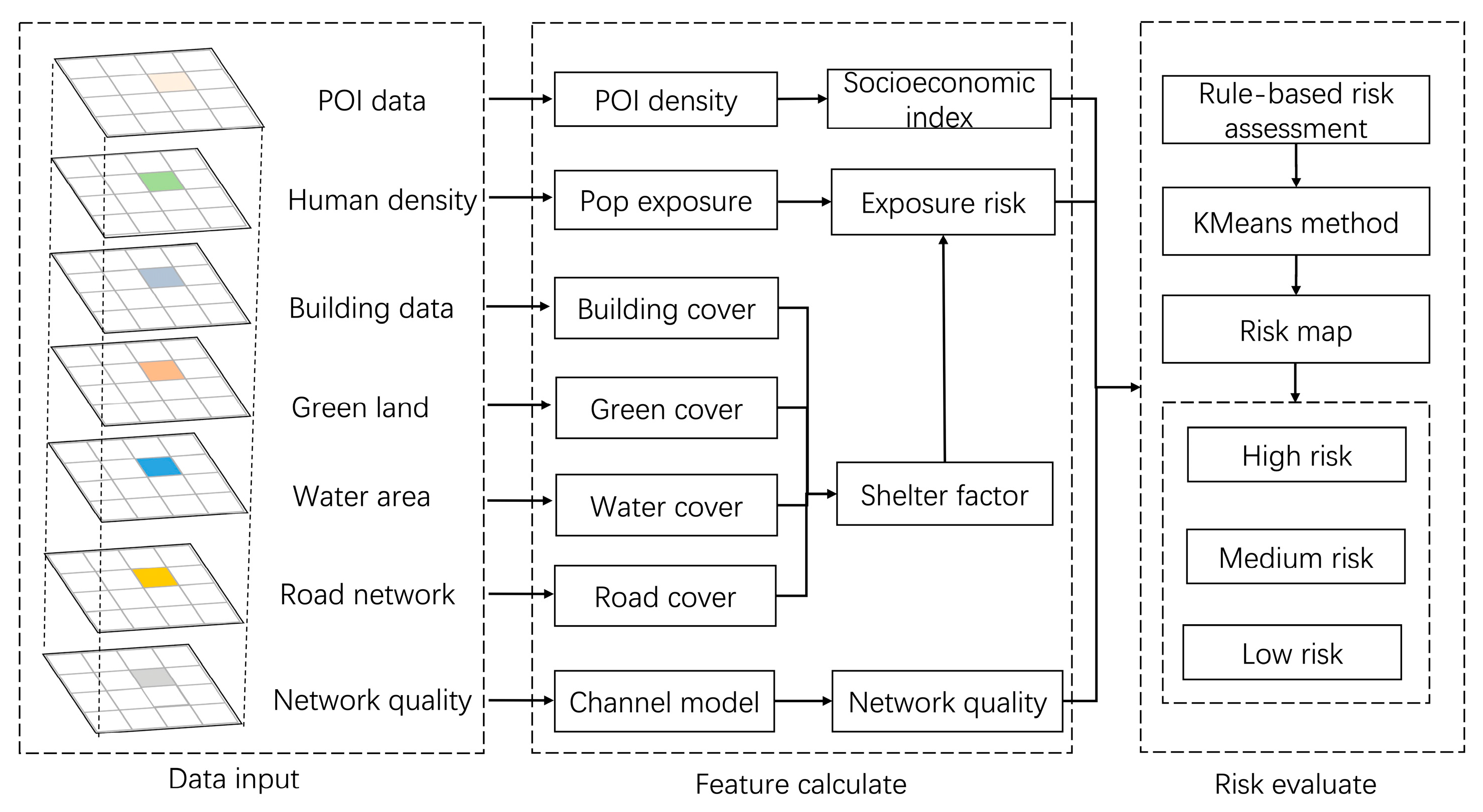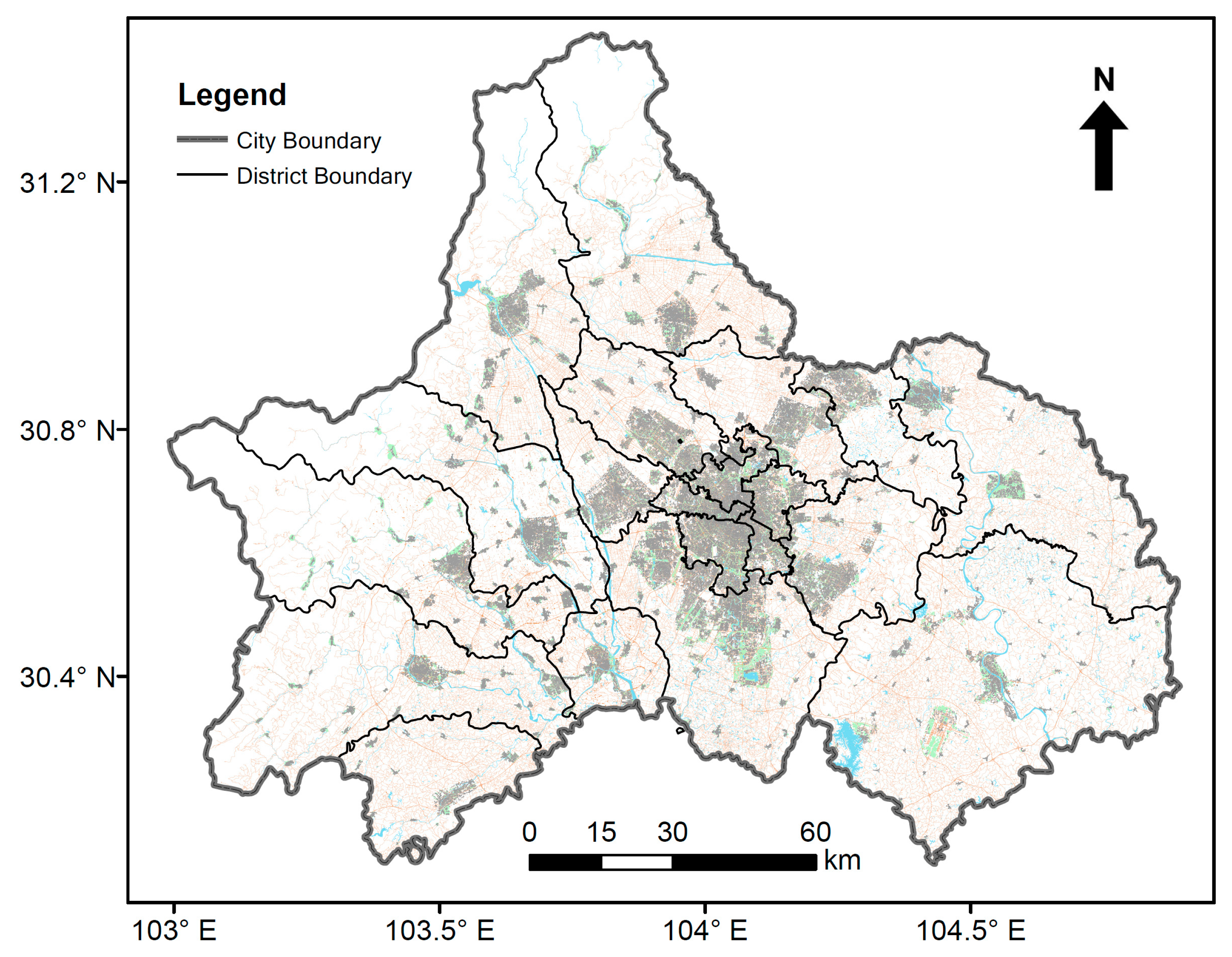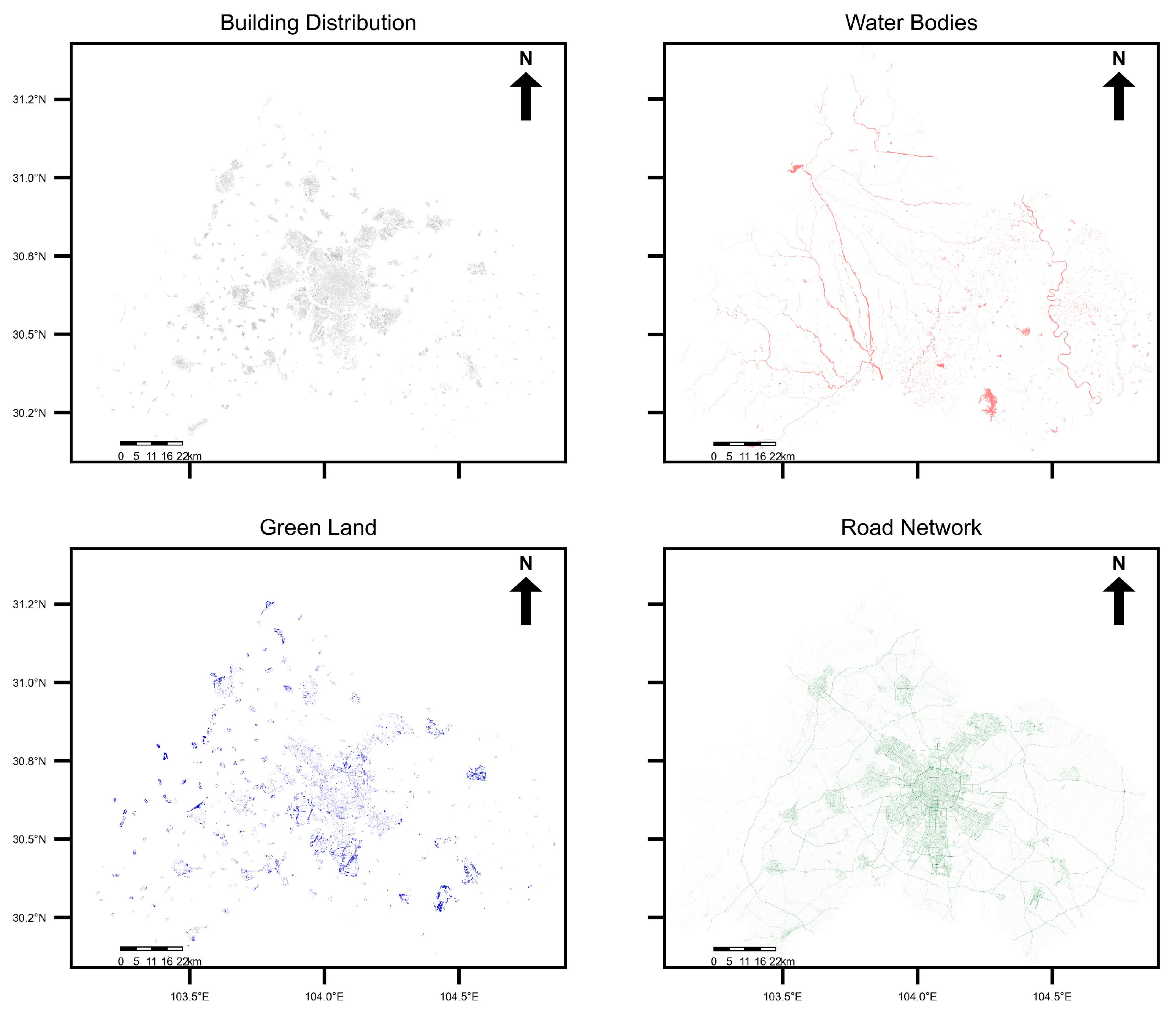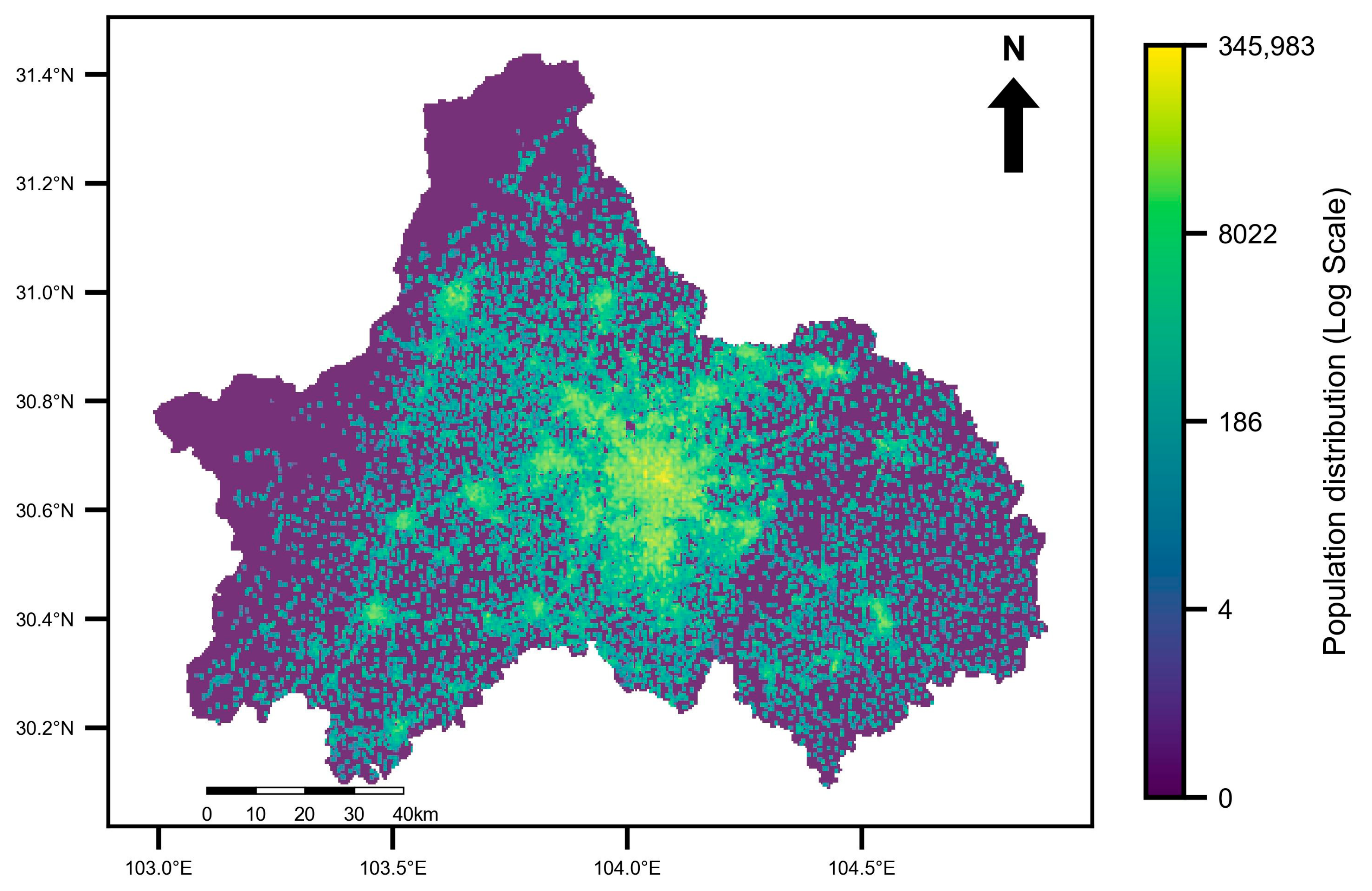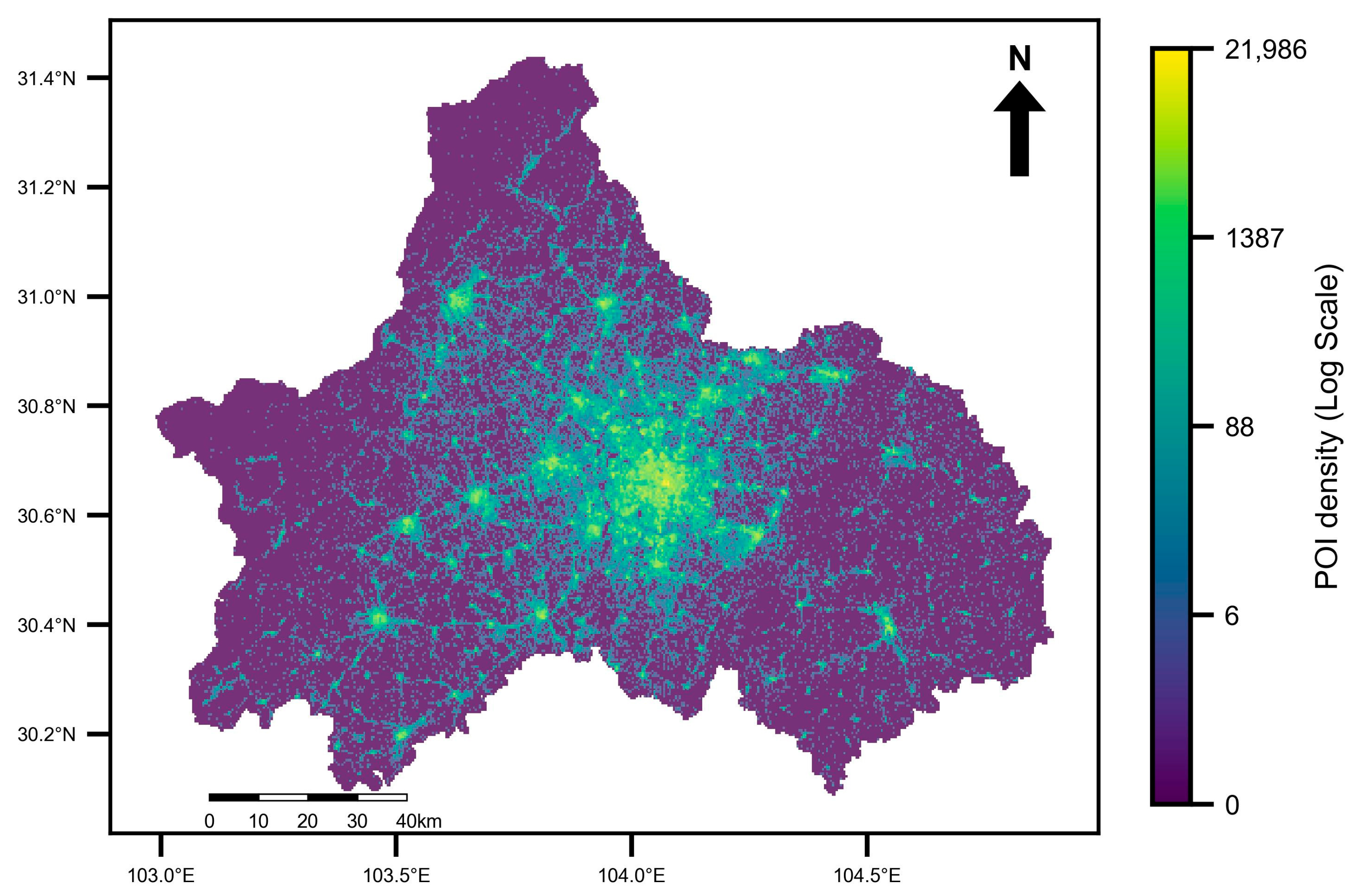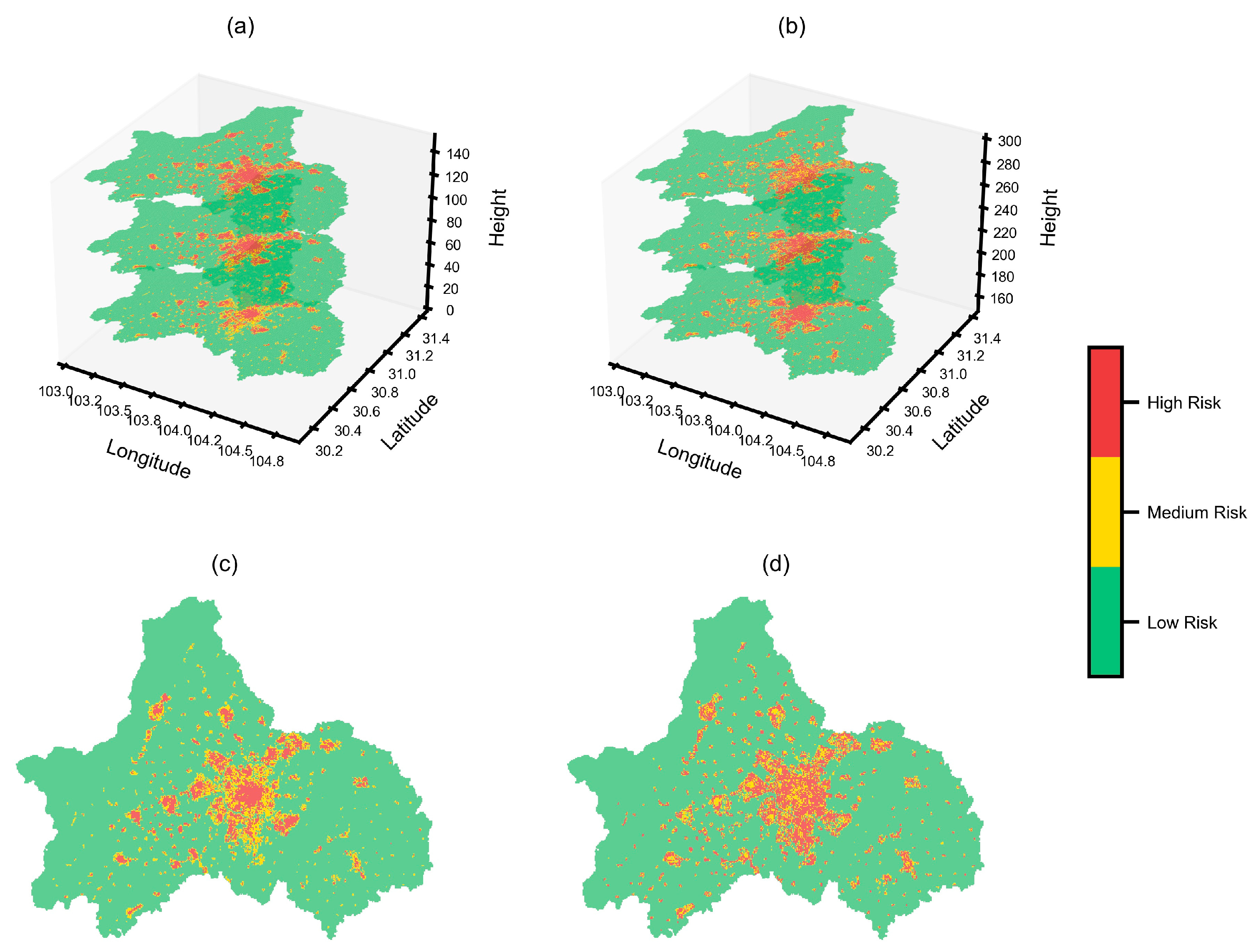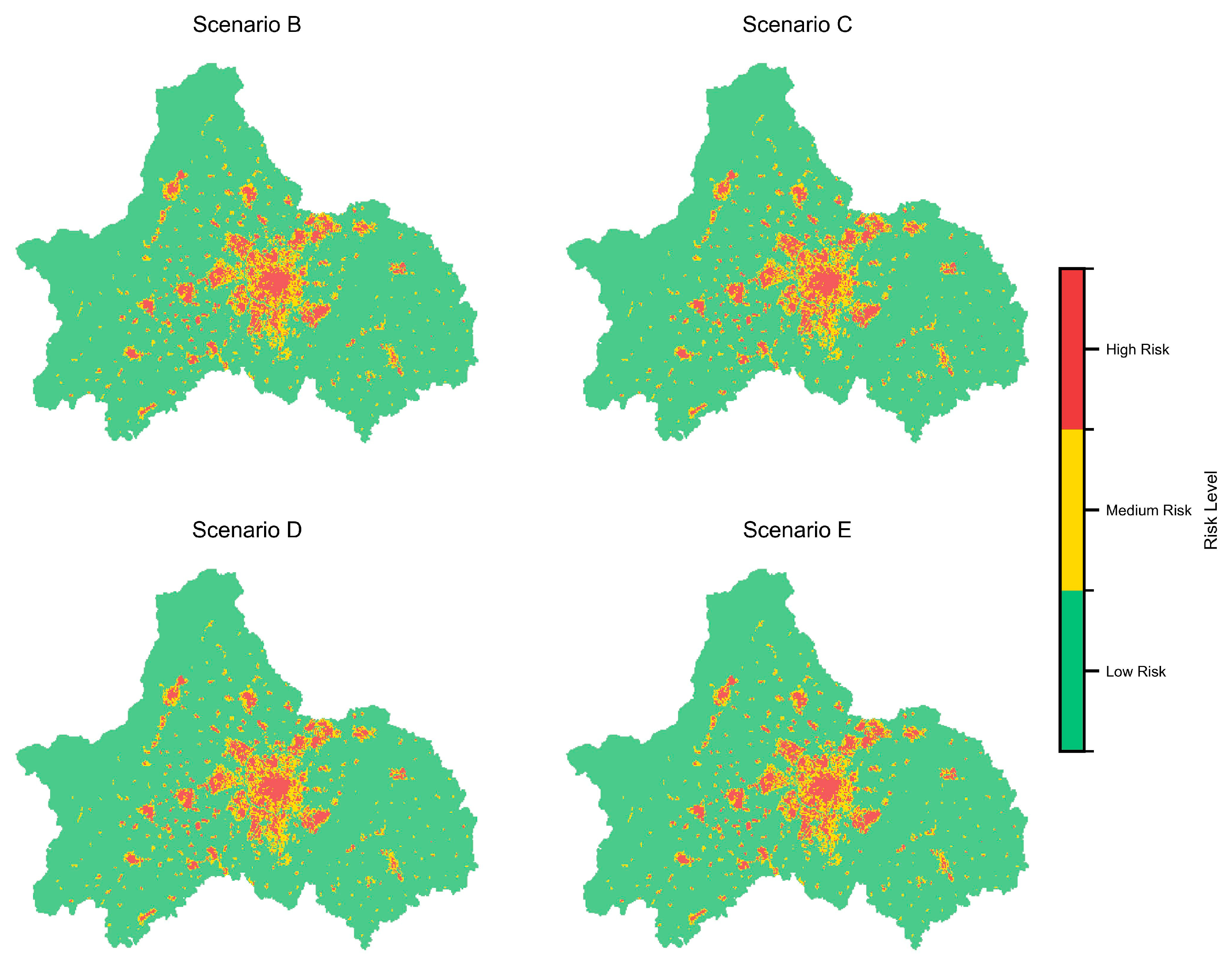1. Introduction
The large-scale utilization of low-altitude resources has become an important factor in promoting low-altitude economic development, and the concept of digital low-altitude ushering in a period of rapid growth, driven by advancements in the Internet of Every- thing [
1]. The unmanned aerial vehicle (UAV) industry serves as a crucial pillar of low-altitude economic development, with a significant increase in UAV applications within urban environments [
2,
3].
To facilitate the rapid development of the UAV industry, it is crucial to ensure the flight safety of UAVs. Given that UAV flights occur predominantly in near-ground, low-altitude, and ultralow-altitude environments, the urban low-altitude environment is relatively complex and variable, posing significant challenges to the safe and efficient operation of UAVs [
4]. The concept of flight risk has been developed to assess the safety of UAV operations. The Joint Authorities for the Rulemaking of Unmanned Systems initially clarified the concept of risk [
5], defining it as a combination of the frequency (probability) of an event and its associated severity. They then proposed the specific operations risk assessment (SORA) method to assess both ground and air risks associated with UAV operations. Air risk refers to the hazards posed by the UAV during flight, influenced by the surrounding environment, other UAVs, or manned aircraft. Ground collision risk encompasses the potential harm to ground personnel and property in the event of an abnormal UAV crash, determined by parameters such as UAV mass, speed, ground environment and mitigation measures (for example, personnel, ground risk buffer zones) [
6]. However, the SORA method is largely qualitative, making it challenging to accurately quantify flight risks from UAVs.
Numerous studies have proposed quantitative methods to assess UAV flight risks. As early as 2008, Dalamagkidis et al. [
7] introduced a relatively straightforward method for evaluating ground impact risks of UAVs. This method constructs a fatality probability model based on UAV physical and operational characteristics, along with two key parameters that affect ground impact: population density and shelter factor. The model quantifies risk by employing the expected number of fatalities resulting from UAV impacts as the primary risk indicator. Lum et al. [
8] further proposed a comprehensive evaluation model that categorizes Unmanned Aerial Systems (UAS) operational risks into three categories: aircraft collision risk, pedestrian collision risk, and collision risk with inhabited buildings. Building on previous work, Primatesta et al. [
9] improved the collision probability risk model by incorporating obstacle layers and no-fly zones. They emphasized that the type of risk is associated with the UAV type and its fall dynamics. Additionally, they utilized risk maps for both offline and online path planning [
10]. However, most of these studies evaluate static risks. To address this, Ancel et al. [
11] developed a real-time risk assessment framework for UAS operations using Bayesian belief networks. Jiao et al. [
12] employed a CNN-LSTM framework to predict ground population density and combined it with a probabilistic risk model for dynamic ground risk assessment, though their population density data was derived from observation points, limiting coverage across the study area. Beyond airspace considerations, Xu et al. [
13] developed a population exposure risk index for low- altitude public airways, accounting not only for the ground environment but also incorporating weak communication signals in the air. While most research has primarily focused on ground collision risks, Milano et al. [
14] recognized the necessity of assessing mid-air collision risks for UAVs and generated aerial risk maps by considering the collision probability between unmanned and general aviation manned aircraft.
Nevertheless, UAV network connectivity during flight is subject to interference, posing significant challenges for both flight safety and network quality estimation [
15]. Thus, evaluating the signal quality of UAVs within the flight airspace has emerged as a crucial indicator for low-altitude airspace risk assessment. Currently, there are two main methods for assessing the network signal environment. The first method involves drones equipped with onboard communication terminals or detecting devices based on fourth generation (4G) or fifth generation (5G) communication signals. This method can typically obtain indicators such as Reference Signal Receiving Power (RSRP), Signal to Noise Ratio (SNR), bit error rate, and throughput rate to comprehensively evaluate the network environment. However, this method faces challenges in covering the entire urban airspace across different heights. The second method involves developing a network signal evaluation model to assess the signal quality of drones flying in urban areas. Existing research has developed statistical models for air-to-ground path loss to estimate network signal quality in urban environments [
16,
17], but most studies have not sufficiently considered the three-dimensional variations in signals across altitude layers.
Drawing from these studies, we recognize several limitations in current airspace risk assessment algorithms: (1) Current airspace risk maps predominantly focus on two-dimensional assessments, with limited attention to three-dimensional risk evaluations across varying altitude layers. (2) There is limited consideration of risks associated with UAVs during flight, and few studies account for the impact of three-dimensional network signal quality at the urban airspace scale. (3) Most research focuses on a single area or a portion of a city, resulting in a lack of comprehensive large-scale airspace assessments for entire urban areas. To address these issues, we propose a three-dimensional airspace risk assessment method that integrates multi-source data to enable a comprehensive evaluation of airspace risks at the urban scale. This method considers various influencing factors such as human exposure to collision risk, socio-economic factors, and network signal quality. By integrating ground collision risks with aerial flight robustness, the method enhances the dimensionality and accuracy of risk assessment. Moreover, by dividing the airspace into different altitude layers, it facilitates a more precise evaluation of potential hazards UAVs may encounter at varying altitudes. Understanding the airspace risk is essential for developing strategies that ensure the safe and efficient operation of UAVs in urban environments.
2. Research Method
This study presents a three-dimensional low-altitude airspace risk assessment framework that integrates multi-source geospatial and communication data. As illustrated in
Figure 1, the framework comprises three primary modules: data input, feature extraction, and risk evaluation. In the data input stage, multiple datasets are incorporated, including building footprints, green coverage, water bodies, population density, points of interest (POIs), road networks, and network signal strength. Collectively, these datasets characterize the physical environment, human activity intensity, and communication conditions of urban airspace. To better perform airspace calculations, we divide the study area into N*M grids of equal size. Each grid cell is assigned a unique code. All attribute information is spatially joined with the grid cells, storing the relevant attributes using the grid as the basic unit. It should be noted that
Figure 1 primarily illustrates the conceptual workflow and data framework. Detailed descriptions of data sources, acquisition methods, and preprocessing procedures are provided in
Section 3.1.
During feature extraction, these data are transformed into three key dimensions, which form the theoretical basis of the risk model.
Section 2.1 elaborates on the construction of population exposure risk, derived from population density and multiple environmental shelter factors (including building, green, road, and water cover). This section quantifies potential human exposure under UAV failure scenarios and examines how varying land-cover characteristics modulate the degree of protection against crash impacts.
Section 2.2 introduces the socioeconomic index, represented by POI density, to capture the spatial concentration of human activities and evaluate the potential socioeconomic consequences associated with UAV-related incidents.
Section 2.3 describes the modeling of network quality using a statistical radio propagation framework to assess communication reliability across different altitudes. Collectively, these three components—population exposure risk, socioeconomic attributes, and network quality—form the core analytical dimensions of the proposed three-dimensional low-altitude airspace risk assessment model.
Section 2.4 presents the risk evaluation process, where the normalized indicators are integrated through a rule-based weighting scheme, followed by an unsupervised K-Means clustering procedure that classifies grid cells into high-, medium-, and low-risk categories. This multi-dimensional framework enables the model to jointly account for population, environmental, and communication factors, providing a comprehensive theoretical foundation for low-altitude UAV safety assessment.
2.1. Risk of Population Exposure
To begin, we calculate the ground collision risk associated with UAVs, defined as the likelihood of injury or fatality among ground populations resulting from a UAV crash. This risk, often referred to as incident frequency, is commonly assessed using a probabilistic risk model. According to prior research [
18], the model requires population density and the computation of the exposure area for individuals affected by a UAV collision. The exposure area is determined by factors including the average radius and height of a person, the UAV’s average radius, and its glide angle. Next, the probability of injury to an individual in a collision is calculated by considering the shelter factor, the UAV’s mass, and its flight speed. If a collision occurs, the incident rate is generally assumed constant. The incident rate is generally assumed constant if a collision occurs. Finally, by multiplying the exposure area, the individual injury probability in a collision, the post-collision event probability, and the population density, we can estimate the risk of population exposure in the event of a UAV collision.
Here,
represents the risk of a drone collision with ground unit
.
denotes the area of exposure in the event of a collision between an individual and a drone, which depends on the average radius
of the drone, the average radius
of a human, the average height
of a human, and the drone’s glide angle
.
represents the population density of ground unit
, determined by the number of people
and the area of the grid unit
.
represents the probability of an individual being injured in a collision within unit
, which is related to the ground shelter factor
and the kinetic energy generated by the drone upon landing. According to Primatesta et al. [
9], the parameter
represents the impact energy when
and
. And the parameter
represents the impact energy required when
approaches 0, meaning there is almost no ground cover, and the collision probability
also approaches 0. E denotes the expected energy, expressed as
, where
. Here,
represents estimated kinetic energy at the impact location
. This value is a function of the impact velocity
, which may vary with the drone’s mass
and its descent trajectory. Finally,
represents the probability of casualties occurring after a ground collision and is generally considered a fixed value.
2.1.1. Shelter Factor
The shelter factor is defined as the degree to which ground objects can prevent injury to people by obstructing a falling drone. This factor depends on the type and area coverage of ground objects. Common types of ground cover include buildings, green spaces, water bodies, and roads, among others. Some research has established different shelter factors for these ground cover types [
19]. However, a grid unit may contain many different types of shelter factors. The total shelter factor for ach grid unit is calculated by weighting the area of each ground cover type by its corresponding shelter factor. The total shelter factor of the grid unit is then obtained by summing the shelter factor values of all ground covers within the grid unit.
Here,
represents the total shelter factor value of all obstacles in grid unit
,
is the area of grid unit
,
denotes the area of the
-th ground cover of type
within the grid unit, and
represents the shelter factor value for obstacles of type
, with the specific values shown in
Table 1.
2.1.2. Population Density
Population density is a critical indicator for determining crowd exposure risk, which can be calculated using population distribution data. Higher values indicate greater population density and a more crowded area, while lower values indicate a sparser population within the grid unit. There are various methods to obtain population distribution data, such as urban traffic data [
20], mobile phone signaling data derived from individual location records [
21], social media check-in data [
22], and location data from map applications [
23]. Mobile phone signaling data, due to its representation of a large and age-diverse population, is considered to have relatively low bias and more accurately reflects the actual population distribution in urban areas [
24]. The population distribution data derived from mobile phone signaling data represents the number of people staying in a specific location over a given period. In order to ensure the accuracy of ground collision risk assessment, it is crucial to obtain population distribution data with fine spatial resolution, broad coverage, and minimal data bias.
2.2. Measures of Socio-Economic Characteristics
In addition to the impact of drone collisions on ground populations, the potential damage to ground socio-economic infrastructure is also considerable. POIs data describes the spatial location and attribute information of various geographical entities and is commonly used to reflect public perception of specific locations and their functional attributes [
25,
26]. POI data, with its large sample size and rich information, can provide insights into various urban activities. Typically, POI data includes multiple types such as commercial land, finance, green spaces, research institutions, and more. Initially, POI types can be reclassified according to specific scenario requirements into seven major categories: commercial and financial, public facilities, government institutions, transportation facilities, natural land, education and research, and residential land. Subsequently, the density of all POI types within each grid unit can be calculated to represent the economic development level within that unit. A higher POI density may indicate greater economic significance for the area.
represents the total density of all POIs within grid unit , where denotes the number of POIs of type in unit , and represents the area of grid unit .
2.3. Simulation of Network Quality
We propose a statistical radio frequency propagation model to estimate the network environment for drones flying at different altitudes. Evaluating network communication quality in urban airspace requires consideration of parameters associated with urban building [
27,
28], as buildings can significantly obstruct and interfere with wireless signals during drone flights. To address this, we introduce a method for estimating network signal quality over large areas by incorporating surface building data. To differentiate between various urban environments, two key parameters must be calculated:
- (1)
Parameter represents the ratio of the area of all buildings within grid unit to the total area of that grid unit.
- (2)
Parameter
: Assuming that building heights in the city follow a Rayleigh distribution [
29],
is the scale parameter of the Rayleigh distribution for the buildings in grid unit
.
indicates the building height in grid unit.
Based on building environment data within the city, the building parameters for each grid can be determined. A higher value indicates that the grid unit has a larger building footprint area, while a higher value suggests that there are more high-rise buildings within the grid unit.
To estimate signal loss in various building environments, we develop a Line-of-Sight (LoS) path calculation method using the Mean Field approach, referred to as the Mean Layer Method. In the LoS scenario, there are no obstructions between the drone and the ground base station. In contrast, the Non-Line-of-Sight (NLoS) scenario involves obstructions such as buildings or trees that block direct communication between the drone and the ground base station. This method assumes that the statistical properties of buildings within a grid unit are homogeneous, and the impact of buildings at different heights on the signal is only considered at the building edges, without accounting for signal scattering and diffraction caused by building obstructions. First, the probability of obstruction for the LoS path is calculated using the Mean Layer Method:
where
represents the layer radius,
denotes the straight-line distance between the drone and the ground base station,
is the vertical distance between the drone and the ground, and
indicates the number of layers.
is the cumulative Rayleigh probability distribution function with a scale parameter of
, indicating that the random height variable
is less than or equal to
. Additionally, the
must satisfy the condition that
.
In the LoS scenario, path loss can be modeled using the free-space propagation model [
16]. In the NLoS scenario, an additional fixed loss value is incorporated into the path loss calculated for the LoS scenario. Finally, the path losses from both the LoS and NLoS scenarios are weighted and averaged to derive the final path loss distribution.
where
represents the path loss calculation in the absence of obstruction, and
represents the path loss calculation in the presence of obstruction.
represents the carrier frequency, specifically the widely used 4.9 GHz band, with this study considering an operating frequency of 4850 MHz. In practice, this corresponds to the 4.9 GHz allocation of China Mobile (headquartered in Beijing, China)—covering the range 4800–4960 MHz with a total bandwidth of 160 MHz.
represents the straight-line distance between the drone and the ground base station.
represents the speed of light, and
denotes the reference path loss.
We then assess the path loss of network signals at different heights. First, the airspace below 300 m is divided into different height levels at fixed intervals (e.g., 10 m). The airspace at various heights is partitioned using the same grid system as on the ground, with each grid being 500 m by 500 m. Next, drones are randomly sampled within the airspace at different altitudes, while base station locations are randomly sampled within non-building covered areas of the ground grid units. Considering that drones in flight are not influenced by all ground base stations, we assume that drones are primarily affected by base stations within a 500 m radius of the corresponding ground grid center. We employ a Monte Carlo simulation process to model the interaction between drones and ground base stations. By performing multiple simulation iterations, we obtain the mean and confidence interval of the signal obstruction coefficient for each grid, which is then incorporated into the channel propagation model. This allows us to calculate the network signal quality for each grid within a large-scale area.
2.4. Risk Classification Algorithm of Airspace
By integrating the calculated attribute features of each grid unit, we classify the low-altitude airspace risk. These features include population exposure probability risk based on population density and shelter factor, POI density, and network signal quality. A higher population exposure probability risk suggests a greater likelihood of ground casualties in the event of a drone crash. A higher POI density implies greater potential economic loss in the event of a collision. Similarly, higher network signal quality values correspond to better communication conditions for UAV operations.
To avoid discrepancies in classification rules caused by differences in magnitude or meaning among various features, we first normalize the different features to ensure consistency in their scales. Given that different feature indicators contribute differently to airspace risk, we assign different weights to each feature. The standardized data is then multiplied by the corresponding weights to adjust the importance of each feature in the classification process. Finally, we use the adjusted data to train a KMeans method to classify the risk levels of all grid units in the airspace into high, medium, and low levels.
5. Conclusions
Expanding the airspace risk assessment from a two-dimensional to a three-dimensional analysis enables a more comprehensive evaluation of risks across varying heights, thereby effectively enhancing the safety of low-altitude UAV flights and providing a foundation for route planning. Based on this, this paper integrates multiple influencing factors to propose a three-dimensional low-altitude airspace risk assessment method. First, the ground collision risks, which estimate potential fatalities or injuries from UAV crashes, are calculated based on factors such as population density and shelter factors. Additionally, POI density is computed for each region as a socioeconomic indicator to evaluate the impact of UAV crashes on ground socioeconomic infrastructure. Second, a network evaluation model is constructed to assess the quality of network signal losses at different heights across a large-scale airspace. Finally, the ground collision risks, socioeconomic characteristics, and network signal quality for each region are combined and classified into low, medium, and high-risk levels using machine learning algorithms, resulting in a three-dimensional airspace risk map.
The three-dimensional airspace risk map reveals that while the overall risk distribution trend is similar across different height layers, there are significant local variations. The airspace risk generally shows a pattern of high and medium risks interspersed in central urban areas, with low-risk regions predominantly found in peripheral areas, though some medium-to-high-risk regions are also present. Notably, we find that the airspace risk for the same grid unit varies across different heights, further underscoring the necessity of evaluating three-dimensional airspace risks.
Despite the innovative three-dimensional airspace risk assessment method proposed in this study, several limitations remain. First, the method is designed for large-scale airspace, which may reduce the accuracy of local airspace risk assessments. This is because airspace risk is influenced not only by factors considered in this study, such as population density, obstructions, socioeconomic factors, and network signal quality, but also by additional elements like low-altitude airspace usage and the electromagnetic environment. Second, in simulating network signal quality at different altitude layers, we simplified the model by considering only LOS and NLOS scenarios, thereby neglecting the more complex signal obstructions caused by reflections and diffraction between the UAV and ground-based stations [
34]. Given the numerous and complex factors influencing airspace risk, this study focuses on proposing a three-dimensional risk assessment method that integrates multi-source data. Future research will aim to incorporate more variables affecting airspace risk dynamics to improve the accuracy of risk assessments and ensure the safe operation of UAVs in low-altitude environments.
